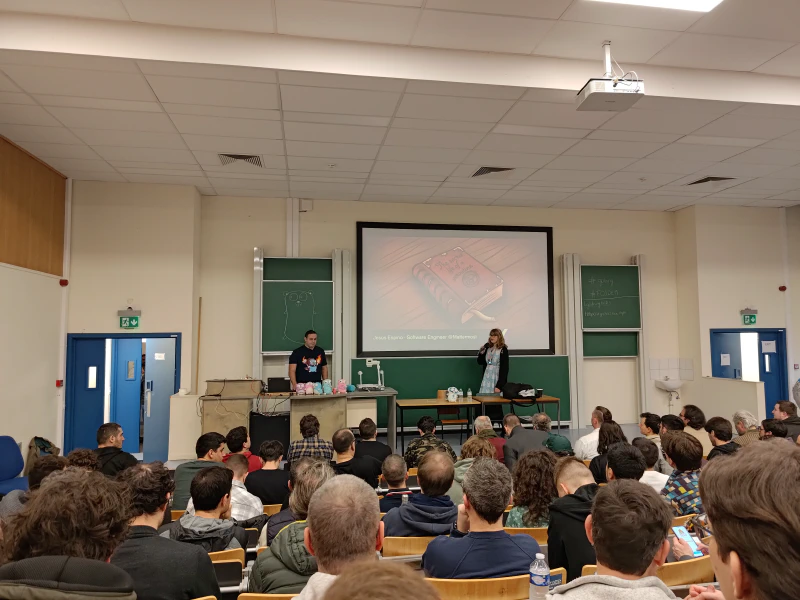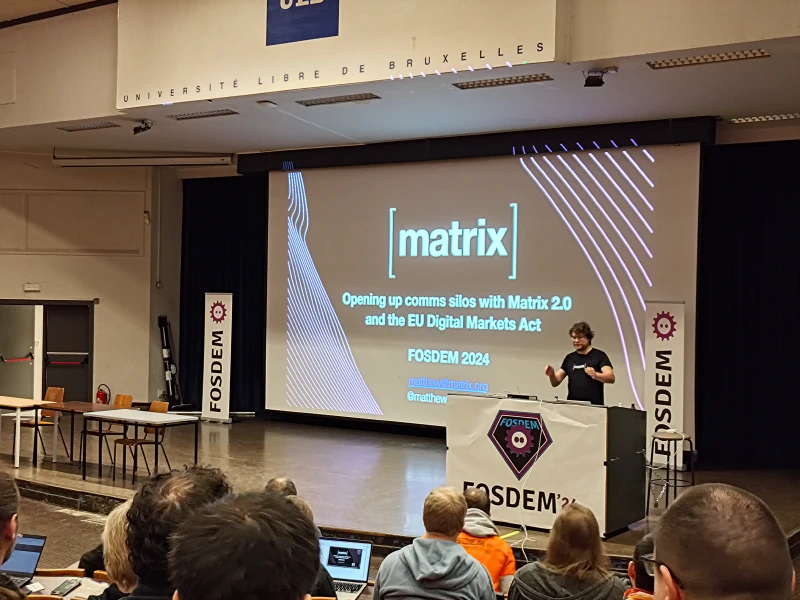Posted
on
in
Travel, Conferences
• 1774 words
• 9 minute read
Tags:
FOSDEM 2024, Matrix, HSBXL, Go (Programming Language), Nix, NixOS, Brussels, Belgium
The primary purpose of my trip was to attend FOSDEM, a Free and Open Source Software conference. I attended last year as well and enjoyed it, so I decided to make the trip to attend again. FOSDEM is the biggest meeting of people in the Matrix community every year, and there is also a sizeable Go presence at the conference as well.
At Beeper, I primarily write Go, and I work extensively on Matrix bridges as well as other Matrix-related projects such as bots and homeservers. I am fortune that the technology that I work on at my job also heavily intersect with the technologies that I’m interested in, so FOSDEM lines up perfectly with my personal and work interests.
Matrix Community Meetup
On the Friday before FOSDEM, the Matrix community once again hosted a community meetup at HSBXL. Probably north of seventy-five people were in attendance including many prominent members of the community. I was able to see many of the people who I’d met at previous Matrix events and I also met quite a few new people as well. Yan and Kim once again did a fantastic job organizing the meetup as a barcamp with an ad-hoc schedule based on the interests of the people in attendance.
I slept in on Friday until just before noon, so I ended up arriving to the meetup late at around 13h after having a nice sushi lunch. Of the people who I met for the first time, I especially enjoyed talking to Travis Ralston who is a spec core team member and Will Hunt (half-shot) who works on bridges at Element. I also enjoyed speaking to Kevin, who was at the meetup representing Fastly and was interested in seeing what they might be able to do to provide a CDN in front of Matrix media. I also enjoyed reconnecting with many people who I’d interacted with at previous events including Ben, Marcel, Nico, Christian, Jan, and many others.
A bunch of people trickled in to the event throughout the afternoon and evening, including my coworker Tulir. Eventually, pizza came, sponsored by Nordeck and Famedly, and great conversations continued throughout the evening.
I’m happy to see that so many people are building on top of Matrix. I believe that the strength of the Matrix project comes from its community, and it’s at meetups like this where the power of the community is truly demonstrated.
Go Devroom
On Saturday, I spent most of my time in the Go devroom. I’ll describe the talks that I found to be most interesting.
The first talk I attended was The Secret Life of a Goroutine by Jesús Espino who discussed the goroutine lifecycle and the basics of how the scheduler allocates tasks across all of the OS threads and processors on the CPU. It was a really fantastic talk and had some fun illustrations for explaining the goroutine lifecycle.

As you can see from just the first slide, it was a very visually appealing presentation.
Another talk that I enjoyed was by Jonathan Hall who discussed the process of becoming a Go contributor. He described his experience going through the process from proposal to getting a change landed in the language. It was interesting to hear about the processes that drive the Go language.
Probably my favourite talk overall was about differential fuzzing, a technique for determining if a rewritten function matches the functionality of the previous function. The speaker, Maciej Mionskowski, was clearly very knowledgable and provided really great examples of how it can be used in practice. Fuzzing is a testing tool in which you produce a bunch of random inputs to try and find edge cases which you haven’t explicitly tested for. The issue with fuzzing is that often you do not know what the correct answer should be given some random input. There are a few ways to deal with this. If the operation has an inverse (marshal and unmarshal for example), performing the full round-trip and ensuring that the random fuzzing input is preserved is a good way to test the functionality. However, sometimes you don’t have such a luxury. In these cases, you can use known-good implementations as a reference and ensure that the old and new implementations agree on the output. Tulir mentioned that it might be a good way to test the functionality of goolm, a pure Go implementation of Olm and Megolm which was contributed to mautrix-go by @DerLukas15. It was a very good talk, and Maciej was very knowledgable with this technique as he had used it to find some bugs in the Go HTML parsing library.
Another talk I enjoyed was by Filippo Valsorda who is working as a full-time professional open source maintainer. His business model is to sell retainers to companies interested in funding his work and having access to his expertise. I’d heard him on a previous Go Time podcast, and it was cool to hear an update a little over a year into his journey. I think that the thing that strikes me the most is his emphasis on making it a true business-to-business transaction, so that the funding can be done in terminology that legal and finance teams can understand and handle easily. For example, instead of asking for donations via some site like Patreon, he sends actual invoices to companies.
Later in the day Dylan Reimerick gave a talk about dependency injection, which is a technique that I hear a lot about, but didn’t really ever understand what it meant until the talk. He mentioned that Go’s interfaces allow for fairly flexible dependency injection, as the dependent package can define an interface that it expects and can then callers can have different implementations as long as they implement the interface. He also provided some tips about defining dependency injection boundaries (he recommended package-level for most cases) and many other tips.
The last talk I attended was about GoReleaser, which is a tool which aims to replace Makefiles in Go projects by automating building, cross-compiling, dockerizing, among other tasks using a declarative YAML file. I’m going to have to look into it for some of my side projects and see if it’s any good.
When I wasn’t at the Go devroom, I was spending time over at the Matrix stand in the sponsor hall, or getting food at one of the food trucks in the plaza between the university buildings.
Later in the evening, I met up with a bunch of Matrix folks at a Vietnamese restaurant. I sat with Yan, Ben, and Tadeusz, and we enjoyed conversations about Matrix, and also about sharing about the different cultures of the countries we live in.
Some Other Talks
On Sunday, I attended some talks about Matrix (see below), but I also spent some time in the Nix devroom and attended a talk about post-quantum cryptography.
The talk that I thought was most interesting in the Nix devroom was one about automatic boot assessment. Basically, it is a feature where if your latest generation fails to boot a few times, then it will revert back to the previous generation and boot from that instead. I think that I’ll try employing that technique on my servers as that will hopefully prevent me from ever having to use the Hetzner console to change the boot target on my servers if I mess up a generation.
I also went to a talk about post-quantum cryptography. I don’t remember the exact name of the devroom, but the speaker talked about post-quantum cryptosystems and their challenges. One of the biggest difficulties is the fact that the key sizes are so much larger in quantum-resistant cryptosystems. Additionally, the systems require a hybrid approach (using both a quantum-resistant and a classically-resistant algorithm together) which balloons complexity.
Focused on Matrix
On Sunday morning, Matthew gave a keynote about the state of Matrix on the FOSDEM main stage. He provided an update on the Matrix Foundation and the progress that the ecosystem has made over the past year.

He talked about the progress that the Matrix Foundation has made in helping shape the implementation of the DMA. He discussed a potential architecture for allowing interop to occur between gatekeeper clients (Facebook Messenger and WhatsApp) and Matrix clients. It seems like the biggest challenge will be agreeing on a standard message format. I have a feeling that the gatekeepers will just publish their event format and require interoperating services to implement whatever message format they say. This will necessitate having clients interpret the gatekeeper message formats. This could be done with a message format converter that takes the gatekeeper message format and converts it to Matrix, but that will basically require bridge code to be embedded into the client. Of course, ideally the gatekeepers would adopt a standard format such as Matrix events, but I think that is unfortunately very unlikely. That being said, I think that the Foundation’s advocacy work with the DMA regulators is extremely important, and any pressure they can apply to gatekeeper organisations is beneficial to the entire ecosystem.
Matthew also discussed the things that the Foundation focused on in the last year. Thankfully, they have stopped funding the many absurd projects such as thirdroom, low-bandwidth Matrix, and P2P Matrix that were diverting valuable Foundation resources away from promoting Matrix as a truly open, truly decentralised, and truly privacy-first protocol that can become the industry standard for interoperable communications. I’m excited about this new focus from the Foundation.
In the afternoon, there was also a Matrix devroom. The talk I was most interested in was by Travis Ralston about the technical aspects of the DMA interop that Matthew had discussed during the keynote. I think that it will be interesting to see how the DMA actually gets enforced and how the gatekeepers will implement interop.
In all, I enjoyed my time at FOSDEM, and I learned a lot about a variety of topics. I also was able to meet new people and interact with people I’d already met at previous events. The Matrix project’s strength is its community which consists of a great group of people who are building a myriad of applications under a diverse set of requirements across many industries. As long as the Matrix community is strong, the project will be strong. Right now, the community is strong, but we must keep focused on the goal of an interoperable, decentralised, open, privacy-first chat ecosystem. I’m excited to see what progress we make towards this goal in the next year!
